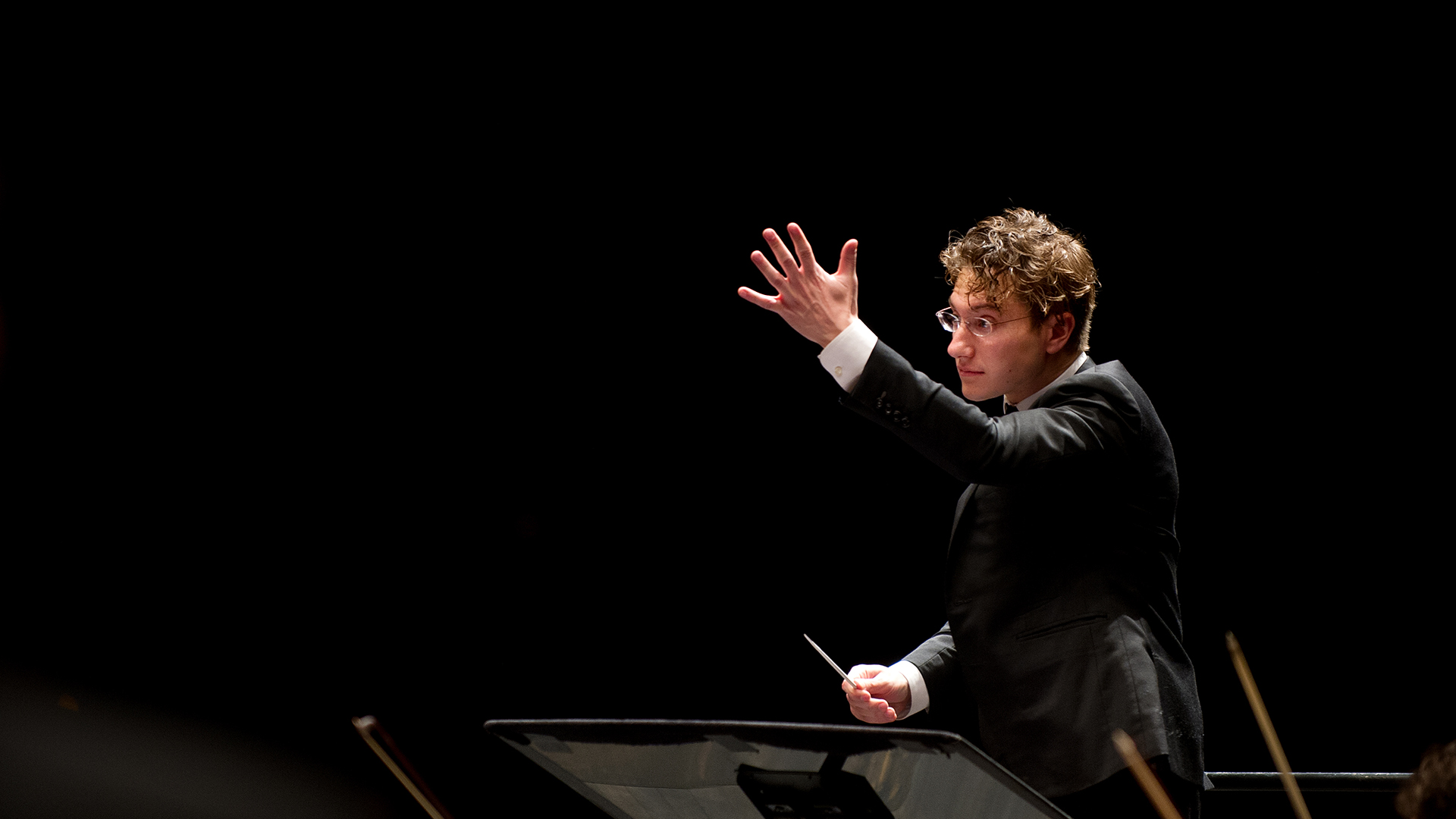Mason Bates is a composer, DJ and curator who pushes the boundaries of musical styles. Teddy Abrams was named Conductor of the Year 2022 in the USA.
A fairy jumps from one music stand to another, a flying lion chases horses, an island animal devours sirens. Mason Bates is a composer, DJ and curator who pushes the boundaries of musical styles. Teddy Abrams, music director and conductor of the Louisville Orchestra, was named Conductor of the Year 2022 in the USA. “Whether writing and premiering a rap-opera honoring Muhammad Ali or promoting the power of Black music, he’s always looking for ways for orchestras to empower their musicians.” (Musical America)
Teddy Abrams
Teddy Abrams (born 1987) is an American conductor, pianist, clarinetist, and composer. He has been Music Director of the Louisville Orchestra in Kentucky, USA, since 2014. In the summer of 2023, Abrams stepped down from the podium, concluding his ten-year tenure as Music Director of Oregon's Britt Festival Orchestra. Abrams was named Musical America’s Conductor of the Year in 2022.
Abrams was born and raised in California. He began studying conducting with Michael Tilson Thomas, Music Director of the San Francisco Symphony, at age 12. His further studies led him to the San Francisco Conservatory of Music, as well as to the Curtis Institute of Music and Aspen Music Festival and School.
Abrams’ rap-opera premiered in 2017. Among Abrams’ recent compositional highlights is Mammoth, an immersive work performed in Kentucky’s Mammoth Cave, a UNESCO World Heritage Site, in April 2023. Currently, Abrams is working on ALI, a new Broadway musical about boxing legend Muhammad Ali, which is scheduled to have its world premiere in autumn 2024.
Autumn 2023 will see Abrams is making his debut with the Helsinki Philharmonic Orchestra.
Teddy Abrams
Mason Bates: Anthology of Fantastic Zoology
US composer Mason Bates (b. 1977) is known for his operas, film scores and symphonic works, as Musical America’s Composer of the Year 2018 and already the winner of two Grammy awards. The interlocking movements of his Anthology of Fantastic Zoology are based on the Book of Imaginary Beings (1957) by Luis Borges and Margarita Guerrero that is, says Bates, “a kind of psychedelic Carnival of the Animals”.
The imaginative creatures provoke new sounds and instrumentation, with a special focus on spatial possibilities. For example, the opening Sprite hops from music stand to music stand, even bouncing offstage. The A Bao A Qu is a serpentine creature that slithers up a tower, then slides back down. Nymphs features two clarinets, while The Gryphon uses timpani and brass to conjure a flying lion that hunts horses. The lyrical core of the piece, Sirens, features offstage violins but is short lived, as the island they approach devours them in The Zaratan. The finale occurs at the moment between midnight and dawn, as the animals fuse together in the darkest, deepest part of the forest.
Modest Mussorgsky: Pictures at an Exhibition
Modest Mussorgsky (1839–1881) wrote his Pictures at an Exhibition after visiting an exhibition held in honour of his architect-painter friend Vladimir Hartmann, who had died at the age of just 39. In his music, Mussorgsky imagined himself promenading from one picture to another, and was so inspired by what he saw that he sat down and composed the work in only a couple of days. Of the hundreds of works on show, he chose 10 painted by Hartman on his travels in Europe: The Gnome, The Old Castle and the Tuileries in Paris, Bydlo (Cattle) in Poland. The Ballet of Unhatched Chicks evokes the costumes designed by Hartman for a ballet, while Samuel Goldenberg and Schmuÿle catches a conversation between two Jews, one rich and the other poor. From Limoges. The Market the visitor descends into the Catacombs to converse with the dead. Baba Yaga describes the hut on fowl’s legs inhabited by the witch of that name, and The Great Gate at Kiev rounds off the set with a variation of the Promenade theme that has linked the pictures together.
Many composers and conductors have orchestrated the original piano score. Tonight’s is the version most often performed and was made by Maurice Ravel in 1922.
Violin 1
Pekka Kauppinen
Mari Poll-Novakovic
Tuuli Talvitie
Elina Lehto
Totti Hakkarainen
Ilkka Lehtonen
Maiju Kauppinen
Helmi Kuusi
Kari Olamaa
Eija Hartikainen
Petri Päivärinne
Jani Lehtonen
Katariina Jämsä
Lina Leikola
Taru Kircher
Aada Kuoppa
Violin 2
Maaria Leino
Krista Rosenberg
Teija Kivinen
Eva Ballaz
Heini Eklund
Harry Rayner
Dhyani Gylling
Teppo Ali-Mattila
Matilda Haavisto
Terhi Ignatius
Pia Sundroos
Liam Mansfield
Pauline Fleming-Unelius
Virpi Taskila
Viola
Petteri Poijärvi
Mariette Reefman
Liisa Orava
Aulikki Haahti-Turunen
Kaarina Ikonen
Jaakko Laivuori
Hajnalka Standi-Pulakka
Ada Koivukangas
Carmen Moggach
Tiila Kangas
Hanna Pakkala
Cello
Tuomas Ylinen
Lauri Kankkunen
Beata Antikainen
Ilmo Saaristo
Veli-Matti Iljin
Joanna Hanhikoski
Mathias Hortling
Jaakko Rajamäki
Saara Särkimäki
Fransien Paananen
Bass
Mehdi Nejjoum-Barthélémy
Ville Väätäinen
Jani Pensola
Adrian Rigopulos
Tuomo Matero
Paul Aksman
Eero Ignatius
Juraj Valencik
| Flute
Kerttu Aalto-Setälä
Elina Raijas
Senja Mäki
Oboe
Hannu Perttilä
Francisco Almazán
Nils Rõõmussaar
Clarinet
Anna-Maija Korsimaa
Nora Niskanen
Heikki Nikula
Bassoon
Markus Tuukkanen
Asko Padinki
Noora Van Dok
Horn
Ville Hiilivirta
Hannu Kilpi
Joonas Seppelin
Jonathan Nikkinen
Trumpet
Thomas Bugnot
Obin Meurin
Mika Tuomisalo
Pasqual Llopis Diago
Trombone
Francisco Couto
Anu Fagerström
Jussi Vuorinen
Tuba
Ilkka Marttila
Timpani
Tomi Wikström
Percussion
Xavi Castelló Aràndiga
Tuomo Lassila
Kazutaka Morita
Tuija-Maija Nurminen
Naoki Yasuda
Harp
Minnaleena Jankko
Saara Olarte
Keyboard
Fanny Söderström Saxophone Olli-Pekka Tuomisalo |

